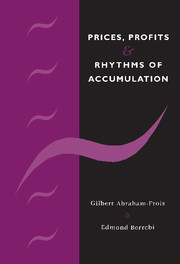Book contents
- Frontmatter
- Contents
- Preface
- 1 The golden rule of accumulation and prices
- 2 Systems of production prices
- 3 Irregular and decomposable systems
- 4 The analysis of joint production
- 5 Standards and blocking goods
- 6 Labour values and the problem of transformation
- 7 Switch in methods of production
- 8 The dynamic evolution
- Notes
- References
- Index
7 - Switch in methods of production
Published online by Cambridge University Press: 06 July 2010
- Frontmatter
- Contents
- Preface
- 1 The golden rule of accumulation and prices
- 2 Systems of production prices
- 3 Irregular and decomposable systems
- 4 The analysis of joint production
- 5 Standards and blocking goods
- 6 Labour values and the problem of transformation
- 7 Switch in methods of production
- 8 The dynamic evolution
- Notes
- References
- Index
Summary
Up to now the analysis of production-price systems has been carried out within a context of ‘square’ systems, assuming that the number of methods of production was equal to the number of economic goods. We shall relax this restrictive assumption in the present chapter: let us now suppose that, to produce one of the commodities, we may choose among several methods of production. What choice criteria shall we use, and what will be the consequences of such a choice?
We shall first address the problem using systems with single-product industries and circulating capital, or for short, ‘simple production systems’. Then we shall develop the specific problems that arise in joint production systems, more particularly the problem of the life span and depreciation of machines. Finally, we will analyse the relationship between linear programming and the production price theory.
Prior to this, we shall put the emphasis on the importance of distinguishing the truncation of the system and the choice of methods of production, the latter being based on a production cost minimisation criterion.
Truncation of the system and choice of methods of production
We have already remarked that in ‘simple’ production, Sraffa (1960) carried out his analysis directly within a square system, ‘as if’ the problem of choosing a method of production did not exist or had been solved earlier. In the beginning of chapter 7 dealing with ‘joint production’, it is stated as a necessary rule, so to speak, that ‘the number of processes is to be brought to equality with the number of commodities so that the prices may be determined’.
- Type
- Chapter
- Information
- Prices, Profits and Rhythms of Accumulation , pp. 176 - 216Publisher: Cambridge University PressPrint publication year: 1997



